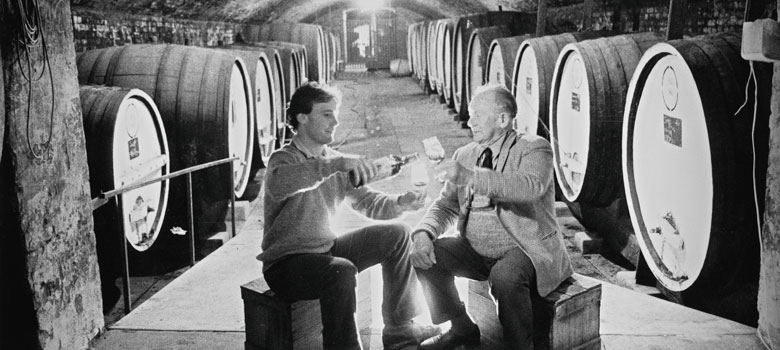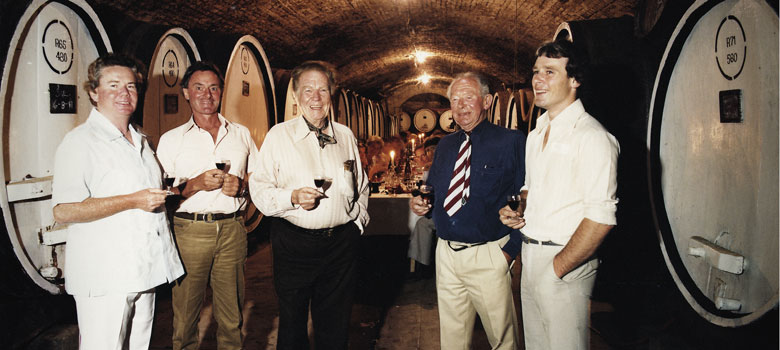Continuing Tahbilk's 160th anniversary, we celebrate the contribution of fourth generation winemaker Alister Purbrick.
It’s an important year for the iconic Tahbilk winery in Central Victoria’s Nagambie Lakes wine region. The Purbrick family is celebrating the 160th anniversary of the foundation of one of Australia’s most admired, family-owned wineries. A winery that has been undertheir custodianship for five generations.
Its formidable reputation is grounded in tradition; in pedigree. Its history is rich in both the stories of the characters behind the wines and the wines themselves, which have a reputation for being both long-lived and speaking of the land from which they come.
The land on which Tahbilk lies in the Nagambie Lakes wine region, some 120 kilometres north of Melbourne, is a special slice of Australia. With its 11 kilometres of frontage to the Goulburn River and a further eight kilometres of backwaters and anabranches, the iron- rich sands and soils of the river flats have proven to be ideal for growing vines and producing some of Australia’s most famous wines, including Tahbilk’s flagship 1860 Vines Shiraz.
John, Eric and Alister Purbrick; Alister admires the McWilliams Drainers in the cold-fermentation cellar, 1985
Purbricks at the Helm
Eric Purbrick was the driving force behind Tahbilk in the early days, steering the business through the depression and assuming the role of winemaker with much help from industry friends and his inf luential mentor, Francois de Castella. The change from fortified to table wine came in due course and the winery entered the boom times of the 1960s with a spring in its step, celebrating their centenary to much fanfare in 1960, and Eric became a pivotal figure in the Australian wine industry.
Today Eric’s grandson Alister Purbrick steers Tahbilk confidently into the future. After completing his studies at Roseworthy Agricultural College and sharpening his winemaking skills with vintages at Mildara, Alister took over winemaking duties and became general manager in 1979, and CEO in 1980.
Alister brought with him an intimate knowledge of modern winemaking techniques, which were integrated into the traditional practices the winery was famous for and in a short time, the quality of the wines improved greatly.

Eric and Alister Purbrick in tutorial
As Alister explains, “Tahbilk has long embraced innovation. Grandfather Eric’s decision early on, to concentrate on table wines, is one example way back in the 1930s. His first flagship wine was in 1948 with his Bin 11 Shiraz and I haven’t found any documented, varietally-labelled wines from any other winemakers until the early 1950s. I’m not saying he was the first, but he was certainly amongst the first. Even with Penfolds it was called Grange Hermitage well into the 1990s.”
“When I arrived on the scene, there was quite a bit of fairly ordinary wine sitting in the cellars from some wet vintages during the 1970s. John essentially said to me, ‘I need to employ a qualified winemaker and sort this out; the only question is, is it going to be you or someone else?’”
That was it, Alister came home and by the 1979 vintage they had a brand new 300 tonne white fermentation cellar with all the mod-cons.
“We immediately began to win gold medals with those 1979 wines,” Alister says.
“Don Lewis was a huge help in the early days,” he continues, “and I leant on him for quite a bit of advice based around the region and then I just got on with it!”
Pivotal Characters
The key to great winemaking, Alister says, is surrounding yourself with good people.
“From my first vintage in 1979 up until we employed production manager Neil Larson in 1991, I was the only winemaker here. Neil was a godsend and is still with us today and winemaker Alan George joined us from Mitchelton (1999-present). That meant I was less hands-on and could concentrate more on growing the business. Five years after that, Brendon Freeman joined us on the winemaking team and today that is our core team.”
“A viticulturist by the name of James Baxondale was instrumental in getting our vineyards in shape through the 1980s and was with us until the mid-1990s and today we have Richard Flatman looking after our vineyards who is incredibly knowledgeable and a delight to work with, minimising our inputs as we march to increase our organic plantings.”

Eric, Alister and friends celebrate the 1981 Rhinecastle dinner in the New Cellar
The Purbrick connection also continues with Alister’s daughter Hayley joining Tahbilk in 2009.
“Hayley has taken hold of our environmental plan and really turbocharged that and is really driving our CarbonZero, eco-tourism and sustainability initiatives,” he says.
In this, Tahbilk’s 160th anniversary year, it is fitting to celebrate the five-generations of the Purbrick family involved in Tahbilk’s history; their commitment to treating the environment and their land with respect and their unwavering dedication to producing delicious, contemporary wines that sing true to the estate’s place in Australian wine history.